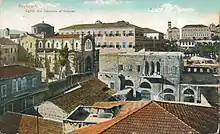St. Louis Cathedral, Beirut
The St. Louis Cathedral[1] also Saint Louis Capuchin Cathedral (French: Cathédrale Saint-Louis de Beyrouth) is a Latin Catholic church in downtown Beirut, located to the north of the Grand Serail and Council of Reconstruction and Development. Built in 1864 by the Capuchin missionaries and named it in the honor of King Louis IX of France. The church is highly noticeable for its sandstone facades, rose-colored wooden windows, and its new towering campanile.[2][3]
| St. Louis Cathedral | |
|---|---|
.jpg.webp) | |
| Religion | |
| Affiliation | Order of Friars Minor Capuchin |
| Year consecrated | 1868 |
| Status | active |
| Location | |
| Location | Beirut, Lebanon |
 The Cathedral shown within Beirut | |
| Administration | Apostolic Vicariate of Beirut |
| Geographic coordinates | 33.897911°N 35.502690°E |
| Architecture | |
| Architect(s) | Edmond Clément Marie Louis Duthoit |
| Style | Romanesque |
| Groundbreaking | 1864 |
| Specifications | |
| Direction of façade | East |
| Materials | Sandstone, marble, limestone |
History

The Capuchins arrived in Beirut in 1628 and did not have a place of worship of their own therefore they used to practice their rites in the old Saint George church where the current Maronite cathedral stands in Downtown Beirut. In 1732, the Capucins built their first church in Beirut near the current site of Riad Solh Square dedicated to Saint Louis IX King of France.
In 1868, they moved to the Bab Edris area and inaugurated the current cathedral also dedicated to Saint Louis. The new cathedral was used for official celebrations at the time of the French Mandate of Lebanon. The congregation was the only Latin parish in Beirut, it was successively managed by the Italian Capuchins (1868-1903), then by the French Capuchins (1903-1952) and currently by the Capuchin Vice Province of the Middle East.
The cathedral was raided in December 1975 and was the scene of fierce fighting between warring factions during the Lebanese civil war. Saint Louis and the adjacent convent were looted and burned and a Lebanese friar, brother Ferdinand Abu Jaoudé, was killed on site. After the end of the hostilities, Saint Louis was the first downtown Beirut landmark to be restored and reopened to the public in 2000.[2][4]
Timeline
- 1626: Presence of Capuchin missionaries in Beirut.
- 1732: Transfer of their establishment to Bab Derkeh.
- 19th century: Establishment of the Capuchins on Serail Hill.
- 1864-1868: Capuchin Cathedral built in Byzantine style.
- 1950: Addition of the bell tower.
- 1975-1990: Civil War in Beirut damaged the cathedral.
- December 2000: Inauguration of the Cathedral after renovation works.
Overview
Dedicated to Saint Louis IX, King of France, the Capuchin cathedral was built between 1864 and 1868 in the Byzantine style, designed by architects Luigi Cavelli and Edmond Duthoit. The existing bell tower was added in the 1950s. Damaged during the Lebanese Civil War (1975-1990), the monument underwent general renovation works.
See also
- Architecture of Lebanon
- Capuchin
- Bab Derkeh
- Badriyeh
- Saint Louis IX
- Architect Luigi Cavelli
- Architect Edmond Duthoit
References
- "Cathédrale Saint-Louis, Beirut, Lebanon". www.gcatholic.org. Retrieved 2016-11-25.
- http://d3f37fhpx4vrrf.cloudfront.net/Recreations/Downtown/Saint-Louis-Capuchin-Church/7575
- Gebran, Yacoub. "Eglise". Dictionnaire de l'architecture au Liban au XXème siècle. Alphamedia. Archived from the original on April 7, 2013. Retrieved February 3, 2013.
- capucinsorient.org. "Couvent Saint Louis - Bab Edriss". capucinsorient.org. Retrieved February 9, 2013.
- Kassir, Samir (2003) Histoire de Beyrouth, Fayard, Paris.
- Information provided by Frère Raymond – Saint Louis Capuchin Cathedral.